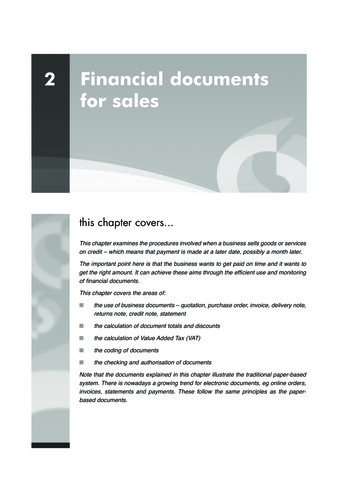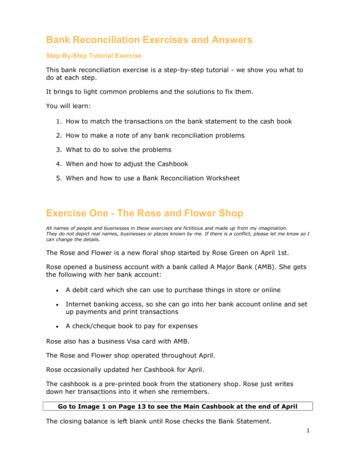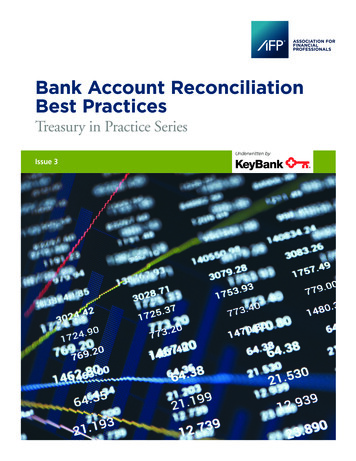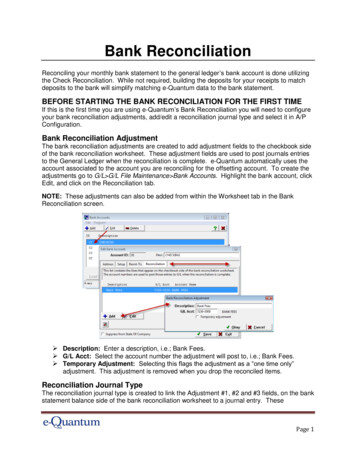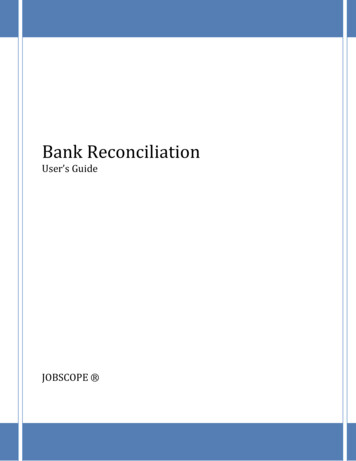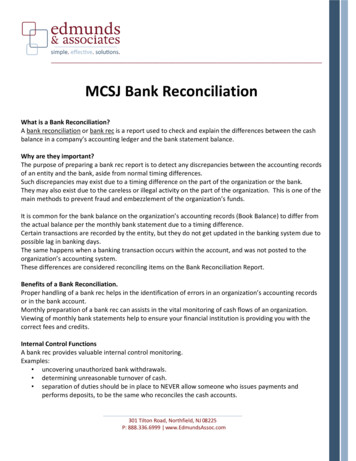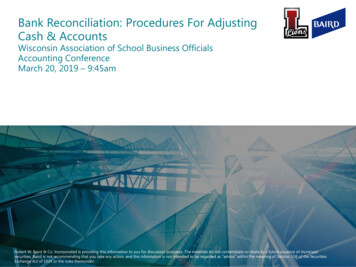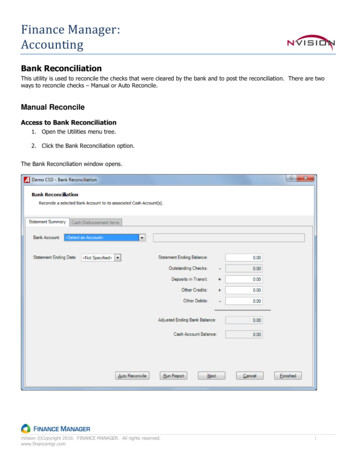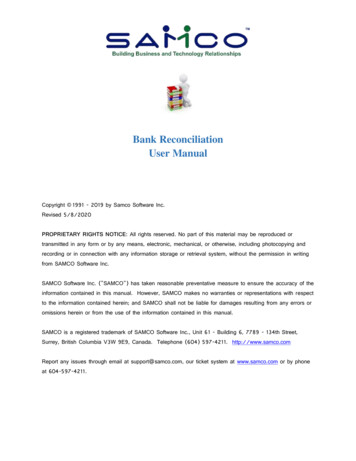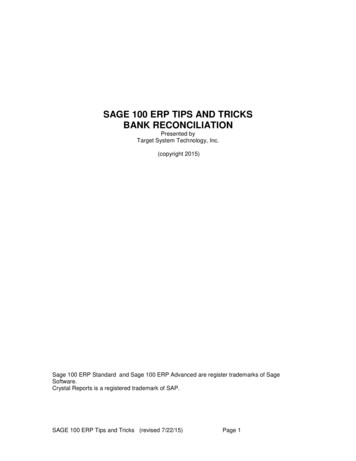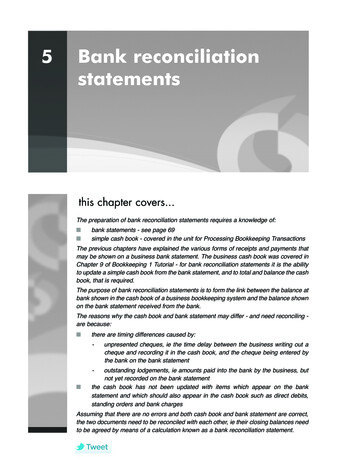
Transcription
5Bank reconciliationstatementsthis chapter covers. this chapter covers.The preparation of bank reconciliation statements requires a knowledge of: bank statements - see page 69simple cash book - covered in the unit for Processing Bookkeeping TransactionsThe previous chapters have explained the various forms of receipts and payments thatmay be shown on a business bank statement. The business cash book was covered inChapter 9 of Bookkeeping 1 Tutorial - for bank reconciliation statements it is the abilityto update a simple cash book from the bank statement, and to total and balance the cashbook, that is required.The purpose of bank reconciliation statements is to form the link between the balance atbank shown in the cash book of a business bookkeeping system and the balance shownon the bank statement received from the bank.The reasons why the cash book and bank statement may differ - and need reconciling are because: there are timing differences caused by:-- unpresented cheques, ie the time delay between the business writing out acheque and recording it in the cash book, and the cheque being entered bythe bank on the bank statementoutstanding lodgements, ie amounts paid into the bank by the business, butnot yet recorded on the bank statementthe cash book has not been updated with items which appear on the bankstatement and which should also appear in the cash book such as direct debits,standing orders and bank chargesAssuming that there are no errors and both cash book and bank statement are correct,the two documents need to be reconciled with each other, ie their closing balances needto be agreed by means of a calculation known as a bank reconciliation statement.
bank reconciliation statements77R E C E I V I N G T H E B A N K S TAT E M E N TWhen the bank statement is received it must be matched or compared withthe cash book in order to identify any differences or discrepancies.These differences are: timing differences updating items for the cash booktiming differencesThe two main timing differences or discrepancies between the bank columnsof the cash book and the bank statement are: unpresented cheques, ie cheques issued, not yet recorded on the bankstatement outstanding lodgements, ie amounts paid into the bank, not yet recordedon the bank statementThe first of these – unpresented cheques – is caused because, when acheque is written out, it is immediately entered on the payments side of thecash book, even though it may be some days before the cheque passesthrough the bank clearing system and is recorded on the bank statement.Therefore, for a few days at least, the cash book shows a lower balance thanthe bank statement in respect of this cheque. When the cheque is recorded onthe bank statement, the difference will disappear. We have looked at onlyone cheque here, but a business will often be issuing several cheques eachday, and the difference between the cash book balance and the bankstatement balance may be considerable.With the second timing difference – outstanding lodgements – thebusiness’s cashier will record a receipt in the cash book as he or she preparesthe bank paying-in slip. However, the receipt may not be recorded by thebank on the bank statement for a day or so, particularly if it is paid in late inthe day, or if it is paid in at a bank branch other than the one at which theaccount is maintained.Until the receipt is recorded by the bank the cash book will show a higherbank account balance than the bank statement. Once the receipt is entered onthe bank statement, the difference will disappear.These two timing differences are involved in the calculation known as thebank reconciliation statement. The business cash book must not be alteredbecause, as we have seen, they will correct themselves on the bank statementas time goes by.
78bookkeeping 2 tutorialupdating items for the cash bookBesides the timing differences described on the previous page, there may beother differences between the bank columns of the cash book and the bankstatement, and these do need to be entered in the cash book to bring it up-todate.For example, the bank might make an automatic standing order payment onbehalf of a business – such an item is correctly deducted by the bank, and itmight be that the bank statement acts as a reminder to the business cashier ofthe payment: it should then be entered in the cash book.Examples of items that show in the bank statement and need to be entered inthe cash book include:receipts - money in credit transfers (BACS – Bankers Automated Clearing Services) amountsreceived by the bank, eg payments from trade receivables dividend amounts received by the bank bank interest receivedpayments - money out standing order and direct debit payments (many businesses keepschedules of their standing orders and direct debits – from these theywrite up the cash book as the payments fall due) bank charges and interest unpaid cheques deducted by the bank, for example, cheques fromcustomers paid in by the business which have ‘bounced’ and are returnedby the bank marked ‘refer to drawer’For each of these items, the cashier needs to check to see if they have beenentered in the cash book; if not, they need to be recorded (provided that thebank has not made an error). If the bank has made an error, it must be notifiedas soon as possible and the incorrect transactions reversed by the bank in itsown accounting records.T H E B A N K R E C O N C I L I AT I O N S TAT E M E N TThe bank reconciliation statement forms the link between the balancesshown in the bank statement and in the cash book:
bank reconciliation statements79bank statementbank reconciliation statementcash book (bank columns)Upon receipt of a bank statement, reconciliation of the two balances iscarried out in the following way: tick off the items that appear in both cash book and bank statement the unticked items on the bank statement are entered into the bankcolumns of the cash book to bring it up-to-date (provided none are errorsmade by the bank) the bank columns of the cash book are now balanced to find the revisedfigure the remaining unticked items from the cash book will be the timingdifferences the timing differences are used to prepare the bank reconciliationstatement, which takes the following format (with example figures):XYZ TRADING LIMITEDBank Reconciliation Statement as at 31 October 20-1Balance at bank as per bank statementLess: unpresented chequesJ LewisABC LimitedEastern Oil Companycheque no 0012378cheque no 0012392cheque no 0012407Add: outstanding lodgementsBalance at bank as per cash book 6010080220300 2452405520525
80bookkeeping 2 tutorialNotes: The layout shown above starts from the bank statement balance, andworks towards the cash book balance. A common variation of this layoutis to start with the cash book balance and to work towards the bankstatement balance (see page 84). If a bank overdraft is involved, brackets should be used around thenumbers to indicate this for the bank statement or cash book balance. Thetiming differences are still added or deducted, as appropriate. Once the bank reconciliation statement agrees, it should be filed becauseit proves that the bank statement and cash book were reconciled at aparticular date. If, next time it is prepared, it fails to agree, the previousstatement is proof that reconciliation was reached at that time.B A N K R E C O N C I L I AT I O N S TAT E m E N TCaseStudysituationThe cashier of Severn Trading Company has written up the business’s cash bookfor the month of February 20-1, as shown below.Note that the cheque number is shown against payments.DrDate20-12 Feb6 Feb10 Feb16 Feb20 Feb23 Feb26 Feb27 FebDetailsCash Balances b/d250.75Sales145.25Sales204.35A AbbottSalesD Richards LtdSalesP Paul LtdBalances b/dCash BookBank 1,340.50208.50466.253 Feb5 Feb12 Feb278.3017 Feb162.3025 Feb353.95600.35Date20-1262.302,605.85586.2524 FebDetailsCash Wages58.60Appleton Ltd 123456Rent123457D Smith & Co 123458StationeryG ChristieBalances c/d12345975.50CrBank The cash balance of 466.25 shown by the cash columns at the month-end has beenagreed with the cash held in the cash box. The bank statement for February 20-1 hasjust been received:
bank reconciliation statementsNational Bank plcAccount titleBartown BranchDateDetails20-12 Feb7 Feb10 Feb17 Feb17 Feb24 Feb24 Feb26 Feb26 Feb27 Feb27 FebBalance brought forwardCreditCheque 123456CreditCheque 123457CreditBACS J Jarvis LtdCheque 123458Direct debit A-Z FinanceCreditBank chargesSevern TradingCompanyAccount numberStatementPaymentsReceipts 00.00353.956781231845Balance tionNote that the bank statement is prepared from the bank’s viewpoint: thus a creditbalance shows that the customer is a payable of the bank, ie the bank owes thebalance to the customer. In the customer’s own cash book, the bank is shown as adebit balance, ie an asset.As the month-end balance at bank shown by the cash book, 586.25, is not the sameas that shown by the bank statement, 1,061.50, it is necessary to compare individualitems in the cash book and on the bank statement for accuracy. The steps are:1Tick off the items that appear in both cash book and bank statement.2The unticked items on the bank statement are entered into the bank columns ofthe cash book to bring it up-to-date. These are: receiptpayments24 Feb26 Feb27 FebBACS credit, J Jarvis Limited 100.00Direct debit, A-Z Finance 150.00Bank Charges, 10.00In double-entry bookkeeping, the other part of the transaction will need to berecorded in the accounts.
82bookkeeping 2 tutorial3The cash book is now balanced to find the revised balance:Cash Book (bank columns)Dr20-124 FebBalance b/dJ Jarvis Ltd1 mar Balance b/d4 586.25100.00686.2520-126 FebA-Z Finance27 Feb Bank Charges28 Feb Balance c/d526.25Cr 150.0010.00526.25686.25The remaining unticked items from the cash book are: receipt 27 Feb – P Paul Limited 262.30 payment 25 Feb – G Christie (cheque no 123459) 797.555These items are timing differences, which should appear on next month’s bankstatement. They will be used in the bank reconciliation statement.The bank reconciliation statement is now prepared, starting with the bankstatement balance of 1,061.50 and using the unticked items from the cashbook which were noted above.SEVERN TRADING COMPANYBank Reconciliation Statement as at 28 February 20-1Balance at bank as per bank statementLess: unpresented cheque, no 123459Add: outstanding lodgement, P Paul LimitedBalance at bank as per cash book 1,061.50797.55263.95262.30526.25This bank reconciliation statement starts with the bank statement balance, andfinishes with the amended balance from the cash book, ie the two figures arereconciled.notes on the case study The unpresented cheque is deducted from the bank statement balance because,until it is recorded by the bank, the bank statement shows a higher balance thanthe cash book. The outstanding lodgement is added to the bank statement balance because, untilit is recorded by the bank, the bank statement shows a lower balance than the cashbook.
bank reconciliation statements83P R E PA R I N G A B A N K R E C O N C I L I AT I O N S TAT E M E N TIn order to help with the Activities at the end of the chapter, here is a stepby-step summary of the procedure. Reconciliation of the bank statementbalance with that shown in the cash book should be carried out in thefollowing way:1 From the bank columns of the cash book tick off, in both cash book andbank statement, the receipts that appear in both.2 From the bank columns of the cash book tick off, in both cash book andbank statement, the payments that appear in both.3 Identify the items that are unticked on the bank statement and enter themin the cash book on the debit or credit side, as appropriate. (If, however,the bank has made a mistake and debited or credited an amount in error,this should not be entered in the cash book, but should be notified to thebank for them to make the correction. The amount will need to be enteredon the bank reconciliation statement.)4 The bank columns of the cash book are now balanced to find the up-todate balance.5 Start the bank reconciliation statement with the final balance figureshown on the bank statement.6 In the bank reconciliation statement deduct the unticked payments shownin the cash book – these will be unpresented cheques.7 In the bank reconciliation statement, add the unticked receipts shown inthe cash book – these are outstanding lodgements.8 The resulting money amount shown on the bank reconciliation statementis the balance at bank as per the cash book.The layout which is often used for the bank reconciliation statement is thatshown in the Case Study on the previous page. The layout starts with thebank statement balance and finishes with the cash book balance. However,there is no reason why it should not commence with the cash book balanceand finish with the bank statement balance: with this layout it is necessaryto: add unpresented cheques deduct outstanding lodgementsThe bank reconciliation statement of Severn Trading Company would thenappear as (see the next page):
84bookkeeping 2 tutorialSEVERN TRADING COMPANYBank Reconciliation Statement as at 28 February 20-1Balance at bank as per cash bookAdd: unpresented cheque, no 123459Less: outstanding lodgement, P Paul LimitedBalance at bank as per bank statement 526.25797.551,323.80262.301,061.50D E A L I N G W I T H U N U S U A L I T E M S O N B A N K S TAT E M E N T SThe following are some of the unusual features that may occur on bankstatements. As with other accounting discrepancies, where they cannot beresolved they should be referred to the accounts supervisor for guidance.out-of-date chequesThese are cheques that are more than six months old. The bank will not
5 The bank reconciliation statement is now prepared, starting with the bank statement balance of 1,061.50 and using the unticked items from the cash book which File Size: 785KBPage Count: 18
